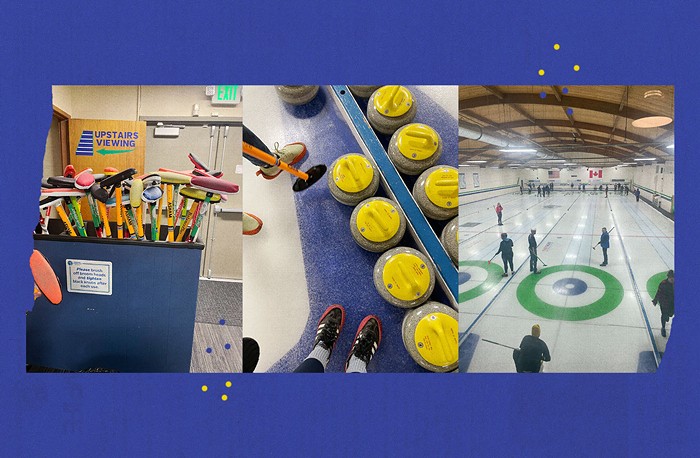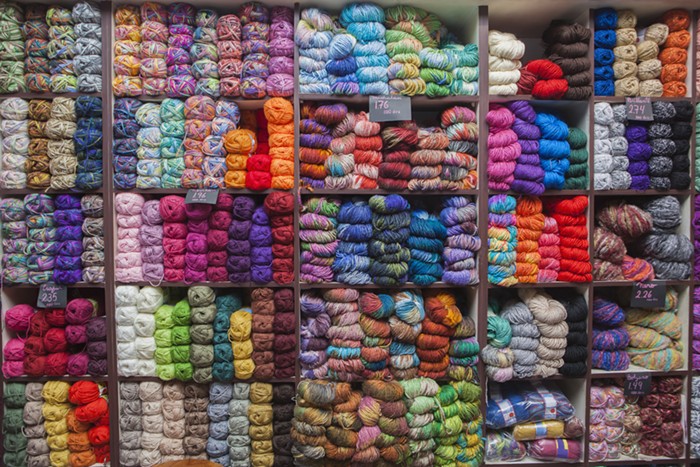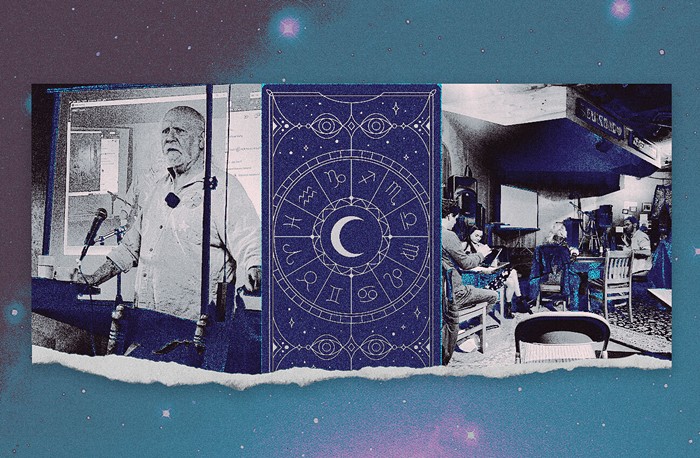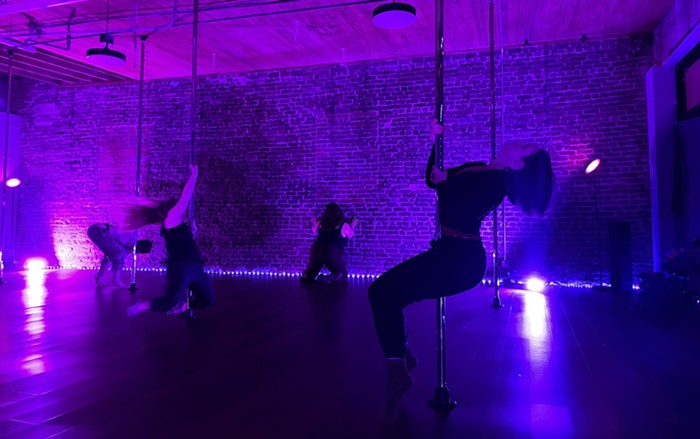My fine motor skills leave a lot to be desired. I didn’t realize this until I tried knitting after the emergency JOANN’s Fabric run my then-roommates conducted in the hours before the world shut down in 2020.
After squinting at a YouTube tutorial, dumbfounded, I gave up. Around me, Dom and Frieda already had full squares of stitches attached to their needles. Even for Nicole, my trusty companion in non-craftiness, knitting clicked. I went to my room and tossed my knitting—if you could call the three loops I’d managed to cast on my needle “knitting”—to the floor.
My yarn—an ugly metallic teal—remained tangled under my desk, caught under my rolling chair’s wheel, still tethered to the needle. It stayed that way until I sold my desk and moved out that summer. In the years since, I’ve glanced at other people’s knitting or crochet projects without feeling, or perhaps idly thinking, "That's good for you, but it's just not for me."
And then, I discovered Knit Night at Seattle Yarn.
For my latest exploration into Seattle subcultures, I sat around a table with a bunch of people wearing their own knitting. They chatted, resting their projects in their laps or on a table strewn with balls of yarn in every hue, knitted purses, and water bottles socked in hand-knit sleeves. In-between light gossip and my asking everyone whether the knit I’d done was actually a knit or a heinous knot, I found a group of people who find solace in their stitches and peace in their purling, but, most of all, they found a home with each other.
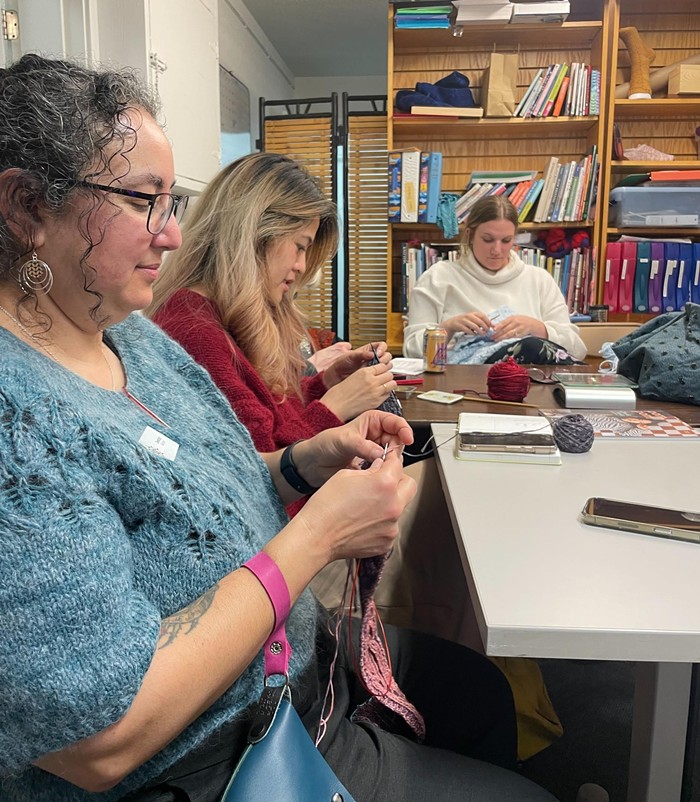
The LYS
The first thing you need to know about the knitting community is it revolves around the Local Yarn Store, or “LYS” in knit-speak. The "LYS" is the community hub for yarn, patterns, classes, and knit nights. It’s the beating heart of the hyper-local knitting scene. The Puget Sound region has one of the most vibrant "LYS" communities—each year, there’s a Puget Sound "LYS" tour that spans five days and 21 shops.
For West Seattle, the "LYS" is Seattle Yarn.
Destiny Itano, 53, discovered Seattle Yarn when she started knitting 18 years ago, pregnant and on bedrest with her twins. Her nurse, who visited twice a week, taught her how to knit to pass the time.
“Time can fly when you get knitting,” Itano said. She liked that her brain shut off while she knit, that she could only focus on one thing. Though, she usually has multiple projects going at once. “I’m a super non-monogamous knitter,” she said.
She didn’t knit in a group until she met Katie Weber, 51.
Weber and Itano went to the same gym. At one gym event, Itano noticed Weber wearing a sweater with a distinctly hand-knit look to it.
“Once you’ve knit you can tell when somebody has made something by hand,” Weber said.
Itano approached Weber in the gym and asked her about her sweater.
Weber, who had been knitting since she was eight—“I’ve been knitting for more than 40 years. That’s terrifying,” she said—only really committed to the craft after knitting her cousin a pair of socks in college. She gained the confidence to knit her first sweater once she moved to West Seattle in 1998. She used mohair, and the result was a monstrosity. The sweater Itano saw was a product of five or six more years of sweater-mastering. At that point, Weber knew how to gauge swatches for sweaters that actually fit, she’d learned cables, and she’d picked a yarn she could frog—or rip out—which you can’t do with mohair. In other words, it looked good.
And so the two got to talking about knitting. Weber eventually invited her to a group that met in a coffee shop every week, and after participating in that group for years, Itano went on to buy Seattle Yarn together with her childhood friend, Cheryl Lea. She's now nurtured a knitting community akin to the one she found all those years ago.
The Group
Weber was part of the group from the beginning. In the early 2000s, a dedicated follower of knitting blogs and the then-new-fangled knitting forum Ravelry, Weber attended a class by a renowned knitter at a different West Seattle "LYS." There, she met the other women who would form the knitting group.
They met every Wednesday at Uptown Espresso in West Seattle.
“We would take their biggest table and hang out and knit and drink tea and have coffee,” Weber said. “I loved it because no one else in my family—with the exception of my mother—did any crafting like this. It was just great to be able to talk in all the lingo, be able to express yourself about your frustrations with a pattern, or ask for help, or do any of that and just have that camaraderie of other people doing stuff that’s similar.”
Week in and week out, the group met and worked on their projects. They saw how much time and effort they each invested in every piece. When someone finished a scarf or a sweater, they heaped praise on each other.
“You would get all sorts of support and love for that project because, ‘Wow, look at what you did,’” Weber told me. She wore a multi-paneled, asymmetrical, blue-and-yellow-striped sweater she knitted from a pattern called “Twitch.” Her socks she made with a yarn called “Mermaids are Real” for the knitting competition she’s currently in, which is called “Sock Madness.”
Itano, wearing a blue sweater she knit in the pattern “Love Note,” told me about the group while she taught me to cast on, to weave the working yarn through my fingers, and to coil it around my pointer finger—or whatever worked for me because everyone has their own way of doing these things—to keep tension in it. She taught me the English style of holding my needles, then the Continental style. We sat in two armchairs in the middle of Seattle Yarn.
“Sometimes there was another knitting group meeting at the same time that was all old ladies,” Itano said.
Jokingly, I asked, “Did you have any beef?”
“No! We didn’t have any beef!” Itano laughed. Then, she paused, considering. She called to the front of the shop. “Elsbeth, we didn’t have any beef with them, or did we?”
Elsbeth Jones, 37, walked over. She wore a yellow cardigan she’d knit herself over a turquoise sweater she'd also knitted. Jones, who discovered the group through a post on the West Seattle Blog forums, said, “It kind of felt like they were more of a class. The woman who was the instructor would come talk to us, but none of the rest of them would.”
No beef, then.
In general, the Seattle knitting scene doesn’t have much drama—at least nothing compared to the scandal when Kirkland-based yarn dyer Goth Socks falsely claimed to have died for 10 minutes.
That’s unsurprising. According to Penny van Kirk, a 49-year-old antiquarian book saleswoman, the coffee shop group was uniquely welcoming. Van Kirk, who’s joined a lot of knitting groups in her 20 years of knitting, said it “was the first group where I felt welcomed, like people cared about whether I showed up.”
Six years ago, when a for sale sign went up in the Seattle Yarn window, the group panicked.
“Somebody was like, ‘Who’s going to buy the shop? We can’t lose the shop.’” Itano said. Weber suggested Itano should buy it. And, she did.
So, Itano took over the place. Jones and other group members started working in the shop. Weber now teaches a two-at-a-time sock-knitting class. The Wednesday night group merged with Seattle Yarn’s existing knitting group, and the welcoming ethos has remained the same.
A Common Thread
All day every Sunday and every other Wednesday evening, the back room of Seattle Yarn fills with knitters. They cram in around a wood table with a center tray full of point protectors, row counters, stitch markers, t-pins, and so on. Then the group, well, knits.
People of all ages and knitting experience show up. They even allow crocheters to join.
Pamela Jorgensen, 77, started knitting when she retired, finding one of her first friend groups outside of her job and her family. Now, she has an all-ages community that she finds invigorating, she said. One thing she really appreciates about the group is how they have each other’s back, even beyond knitting.
“If someone needs some help—some of the older women here are single or live alone—there’s always someone who will come and bring groceries or drive you to a doctor’s appointment, and you never have to ask,” Jorgensen said.
One time, Jorgensen said, someone got shingles during the group.
“That was me!” Ada Sorey, 35, cried from the other room. “It was the third time I had shingles!” Someone from the group drove her to urgent care.
When shop co-owner Lea's stepfather died a few years back, the group organized a blanket drive. Everyone knit a square of a blanket, Weber said, and gave it to the grieving member.
“With our knit group, I've knit blankets to give to other knitters within the group for their first kids,” Weber said.
They’ve taken care of each other through all stages of life, doling out love and support through actions, and, mostly, through their knitting.
Nicole Bishop, 31, is the resident crocheter in the knitting group. Bishop sought out the group after she gave birth to her second child.
"I started coming here when I had really bad postpartum depression," Bishop said. "Coming here and being able to pick all of their brains—a lot of them are moms, they give advice on the different stages—"
"—Whether she likes it or not!" Weber called out, interrupting her.
"—Yeah, whether I like it or not," Bishop smiled. The group has helped, she said.
Bishop’s current project is a giant crocheted blanket of her dead dog, Spike the Shitzu. Spike died nine days after Bishop birthed that second baby.
Bishop said she never really got to process the death, but she's been able to through crocheting. She’s making the blanket in secret so she can give it to her husband for his birthday. "He thinks I’m making a corgi," she said.

Death to the Perfectionist
I sat around the table chatting and focusing on my tiny project, my fingers feeling thick and big as I tried to knit. Occasionally I'd whisper to someone for help, asking whether I’d made a mistake, and then offer them my knitting to fix whenever I'd messed up.
I was not alone. In addition to being supportive emotionally, the group is especially helpful for help solving knitting problems, according to June Hwang, 32, a designer who started knitting less than two years ago. You could never tell she was a novice knitter by the successful creations she posts on her “Knitstagram,” or by the gorgeous round-sleeve oxblood sweater she wore to Knit Night.
“I messed up pretty bad on this,” Hwang said of the red sweater she wore, talking to me as she pored over a grid of numbers and measurements for her current project, a linen-silk knit tank top.
With the sweater, she thought she was going to have to start from scratch when she ran into a problem, but then she brought the sweater to the group, who spread it on the floor, crouched around it, and performed sweater surgery, teaching her as they went.
Those starts and stops and asks for help have been important lessons for Hwang, who said she won't do something at all if she can't do it well. "I used to sew, and once you cut a piece of fabric, it’s cut, but with knitting, if you mess up then you just undo it, nothing lost. The yarn’s still there," she said.
I am well-acquainted with the limits of the perfectionist brain.
When I first arrived at Seattle Yarn, Itano asked whether I wanted to buy any needles to keep practicing after our lesson. I said no, assuming I would hate the process just as I had before and that any needles I bought would end up forgotten and tangled under my current desk.
That need for perfection and that itchy feeling of doing something worse than everyone around me kept me from continuing to knit back in 2020. It made me self-conscious as I squinted and hunched around my needle, maneuvering in and around knits in slow motion.
But once I stopped worrying about being bad—once I messed up and Itano told me to just keep going, that it would turn out fine—I settled into the process. My focus on the mechanics, the needles and the small-scale drama happening at their tips, silenced my internal monologue, a typically-spinning, spiraling thing. Soon, I’d knit four entire rows.
If I had more time, I thought almost longingly, the motions could become rote. As I left, I asked Itano about buying those needles.
Any ideas on which Seattle subculture I should explore next? Want me to tag along with you on your favorite hobby or pastime? Send me tips at playdate@thestranger.com.



